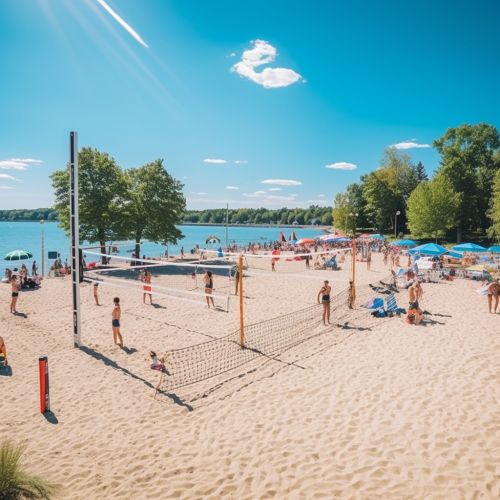Beach volleyball
Overview
Beach volleyball is a team sport played by two teams of two players on a sand court divided by a net. Similar to indoor volleyball, the objective of the game is to send the ball over the net and to ground it on the opponent's side of the court. Each team has three touches to return the ball across the net. The ball is put in play with a serve—a hit by the server from behind the rear court boundary over the net to the opponents. The rally continues until the ball is grounded on the playing court, goes "out", or a team fails to return the ball properly.


History
The history of beach volleyball traces back to the 1920s in Santa Monica, California. While the indoor version of volleyball was already popular, beach volleyball started as family games and gradually gained popularity among the beachgoers. The first official beach volleyball tournaments were organized in the 1930s, and the sport has been growing in popularity ever since. The sport became part of the official program of the Summer Olympics in 1996.
Rules
The rules of beach volleyball are similar to those of indoor volleyball but with some differences. The court is smaller (16 x 8 meters) and there are no rotational positions, meaning players can switch positions at will. The game is played in sets, usually best of three, with each set played to 21 points (15 points for the deciding set). Unlike indoor volleyball, there are no substitutions in beach volleyball, and coaching during matches is not allowed.
Techniques
Beach volleyball requires a variety of skills and techniques, including serving, passing, setting, attacking, blocking, and digging. Serving can be done either from a standing position or a jump serve. Passing is the act of directing a ball coming from the other team in the form of either a serve or other non-attack form of play. The set is usually the second contact that a team makes with the ball. The main goal of setting is to put the ball in the air in such a way that it can be driven by an attack into the opponent's court. The attack is usually the third contact a team makes with the ball. The object of attacking is to handle the ball so that it lands on the opponent's court and cannot be defended.
Strategy
Strategic considerations in beach volleyball can be quite complex, given the variables of weather, sand conditions, and the particular strengths and weaknesses of one's own and one's opponents' game. Teams must decide the best order of serve and the positions of the players on the court. They must also decide when to use particular plays, such as a spike or a block, and how to respond to the opponents' plays.
Equipment
The equipment used in beach volleyball is minimal, but specific. The ball is slightly larger and softer than the indoor volleyball. Players usually wear sunglasses, hats, and bare feet. The uniform consists of a swimsuit for women and shorts for men. The net is 8.5 feet high for men and 7.9 feet high for women.
Professional Beach Volleyball
Professional beach volleyball is a global sport with tournaments and leagues around the world. The most prestigious competitions are the FIVB Beach Volleyball World Championships and the beach volleyball tournament at the Summer Olympics. There are also numerous national and regional tours, as well as amateur and youth competitions.
